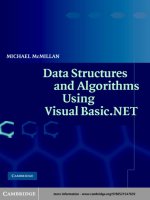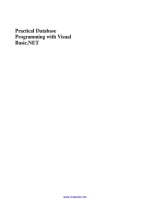Lecture Learning programming using Visual Basic Net – Chapter 1 Problem solving and the objectoriented paradigm
Bạn đang xem bản rút gọn của tài liệu. Xem và tải ngay bản đầy đủ của tài liệu tại đây (74.23 KB, 21 trang )
CHAPTER ONE
Problem Solving and the ObjectOriented Paradigm
Objectives
•
•
•
•
•
•
1- 2
Understand problem-solving concepts.
Formulate algorithms using pseudocode.
Realize the complexity writing algorithms.
Understand an event-driven environment.
Describe how classes and objects work.
Use and understand the terminology of the
object paradigm.
McGraw-Hill/Irwin
©2002 by The McGraw-Hill Companies, Inc. All
rights reserved.
Objectives (cont.)
1- 3
• Demonstrate the difference between visual
and nonvisual software components.
• Begin understanding the relationship of
Visual Basic .NET to the event-driven and
object paradigms.
McGraw-Hill/Irwin
©2002 by The McGraw-Hill Companies, Inc. All
rights reserved.
1.1 Problem Solving
1- 4
• Use computer software to help solve
problems.
– Sample Problem
• Problem Description
– Find the largest number in the set of numbers.
• Describing Your Solution
– Solve the problem yourself.
– Formulate your solution approach.
– Translate your solution.
McGraw-Hill/Irwin
©2002 by The McGraw-Hill Companies, Inc. All
rights reserved.
1.1 Problem Solving (cont.)
1- 5
• Pseudocode (false code) is an outline
style used to document the solution to a
program.
• Algorithm is the formal term for the set of
steps used to solve a problem.
McGraw-Hill/Irwin
©2002 by The McGraw-Hill Companies, Inc. All
rights reserved.
1.1 Problem Solving (cont.)
1- 6
• Algorithms
– A set of ordered steps for solving a problem,
such as a mathematical formula or the
instructions in a program. The terms algorithm
and logic are synonymous. Both refer to a
sequence of steps to solve a problem. Taken
from TechEncyclopedia.com.
McGraw-Hill/Irwin
©2002 by The McGraw-Hill Companies, Inc. All
rights reserved.
1.1 Problem Solving (cont.)
1- 7
• Algorithms (cont.)
– A formula or set of steps for solving a
particular problem. To be an algorithm, a set
of rules must be unambiguous and have a
clear stopping point. Algorithms can be
expressed in any language, from natural
languages like English or French to
programming languages like Visual Basic.
McGraw-Hill/Irwin
©2002 by The McGraw-Hill Companies, Inc. All
rights reserved.
1.1 Problem Solving (cont.)
1- 8
• Getting Data and Displaying Results
– Most algorithms need data.
– You must be able to display the results of an
algorithm.
– Input data must be accurate.
– Algorithm results range from simple to
complex.
McGraw-Hill/Irwin
©2002 by The McGraw-Hill Companies, Inc. All
rights reserved.
1.1 Problem Solving (cont.)
1- 9
• Getting Data and Displaying Results (cont.)
– Major Tasks of a Computer-Base Solution
• Write appropriate computer code to accept and
validate data.
• Write appropriate computer code to implement the
algorithm.
• Write appropriate code to format the results.
McGraw-Hill/Irwin
©2002 by The McGraw-Hill Companies, Inc. All
rights reserved.
1.2 The Event-Driven ProblemSolving Environment
• Most of today’s computer applications are
event driven.
• Helps developer organize a solution into
small segments of code.
• One organizes a solution around a series
of events.
McGraw-Hill/Irwin
©2002 by The McGraw-Hill Companies, Inc. All
rights reserved.
110
1.3 Using the Object-Oriented
Paradigm in Problem Solving
• Classes and Objects
– Payroll System problem.
– Procedural programming has separate data
and program logic.
– Object-oriented programming (OOP)
combines the data and program logic.
– Methods describe the behavior associated
with an object.
– Encapsulates means an object holds in its
capsule both data and behavior.
McGraw-Hill/Irwin
©2002 by The McGraw-Hill Companies, Inc. All
rights reserved.
111
1.3 Using the Object-Oriented
Paradigm in Problem Solving (cont.)
– A class is a definition or template that defines
how objects are created.
– An instance of a class is another name for an
object.
– Special methods known as classes methods
may be accessed by a class.
– Each object instantiated from a class has
identical data elements and methods.
McGraw-Hill/Irwin
©2002 by The McGraw-Hill Companies, Inc. All
rights reserved.
112
1.3 Using the Object-Oriented
Paradigm in Problem Solving (cont.)
• Class Hierarchies
– The “is a” relationship may be used describe
class hierarchies.
– A UML (Unified Modeling Language) class
diagram may be used to define classes.
– A subclass descends from a superclass or
base class.
– A superclass contains data and behavior
common to subclasses.
McGraw-Hill/Irwin
©2002 by The McGraw-Hill Companies, Inc. All
rights reserved.
113
1.3 Using the Object-Oriented
Paradigm in Problem Solving (cont.)
• Inheritance means a subclass acquires all
data elements and behaviors of its related
superclasses.
• Member describes the contents of a class.
• Siblings describe any two or more classes
that descend from the same superclass.
• An abstract class provides a base class
but cannot be used to instantiate objects.
McGraw-Hill/Irwin
©2002 by The McGraw-Hill Companies, Inc. All
rights reserved.
114
1.3 Using the Object-Oriented
Paradigm in Problem Solving (cont.)
• Benefits of Using Object Orientation in
Problem Solving
– Reflects the natural way we think.
– The same class definition can be used in
many applications.
• Supports the concept of code reuse.
– In creating a subclass, we automatically
inherit all members from the superclass.
– Polymorphism enables the same method to
assume different behavior.
McGraw-Hill/Irwin
©2002 by The McGraw-Hill Companies, Inc. All
rights reserved.
115
1.3 Using the Object-Oriented
Paradigm in Problem Solving (cont.)
• Visual versus Nonvisual Components
– Some objects can be seen on the GUI.
– Other objects cannot be seen on the GUI.
– Microsoft provides both visual and nonvisual
components with Visual Basic .NET.
McGraw-Hill/Irwin
©2002 by The McGraw-Hill Companies, Inc. All
rights reserved.
116
1.4 Object Paradigm in Visual
Basic .NET
• Supports both the procedural and objectoriented paradigms.
• Supports both visual and nonvisual
classes.
• Fully supports inheritance and
polymorphism.
• A namespace identifies a set of classes
that are treated as a group.
McGraw-Hill/Irwin
©2002 by The McGraw-Hill Companies, Inc. All
rights reserved.
117
Chapter Summary
• Problem solving with a computer requires the
developer to first solve the problem without a
computer.
• Writing algorithms may be difficult.
• Most computer applications also include code to
obtain input data and to display results.
• An event-driven environment is an application
which responds to events generated by the user
or by the system.
McGraw-Hill/Irwin
©2002 by The McGraw-Hill Companies, Inc. All
rights reserved.
118
Chapter Summary (cont.)
• In an event-driven environment, code is
organized into small units called event
procedures.
• Objects are software components created
from a template called a class.
• Each class template defines data and
behaviors that each object created from
the class possesses.
McGraw-Hill/Irwin
©2002 by The McGraw-Hill Companies, Inc. All
rights reserved.
119
Chapter Summary (cont.)
• Classes can be arranged in hierarchies
that define a set of “is a” relationship.
• Superclasses (or base classes) are at the
top of the hierarchy and subclasses
descend from superclasses.
• A subclass “is a” superclass.
• The object paradigm and polymorphism
provide a very natural and flexible
environment.
McGraw-Hill/Irwin
©2002 by The McGraw-Hill Companies, Inc. All
rights reserved.
120
Chapter Summary (cont.)
• Classes can define visual or nonvisual
objects.
• Most classes created to solve business
problems are nonvisual.
• Visual Basic .NET creates event-driven
solutions that use a combination of the
object and nonprocedural paradigms.
McGraw-Hill/Irwin
©2002 by The McGraw-Hill Companies, Inc. All
rights reserved.
121









